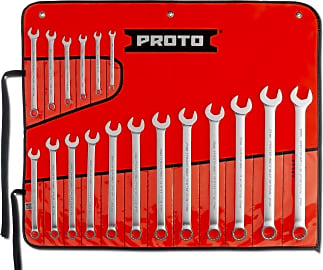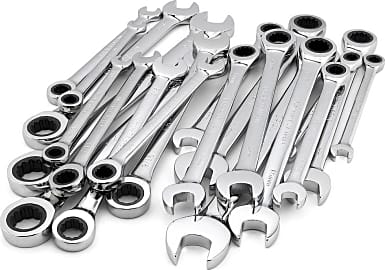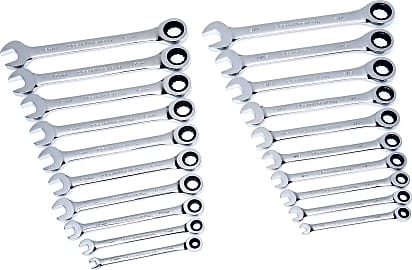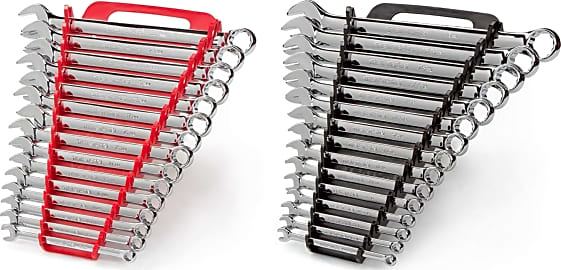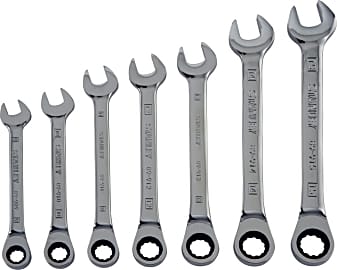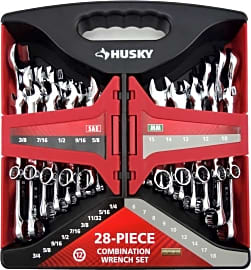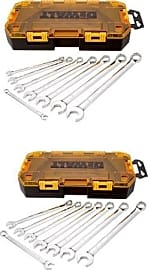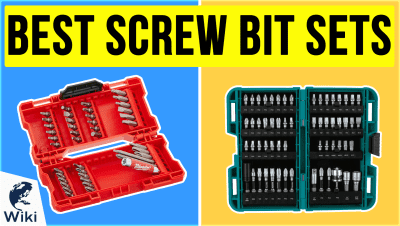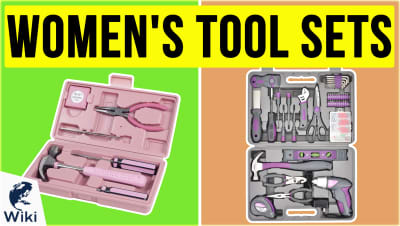The 10 Best Wrench Sets

This wiki has been updated 39 times since it was first published in June of 2015. Whether for a professional workshop or simply to have handy around the home, a good quality wrench set is essential in order to get jobs done quickly and efficiently. Our comprehensive selection includes options in both imperial and metric and are available in a range of sizes. They are priced to meet any budget and are suitable for almost any project from appliance maintenance to automotive work. When users buy our independently chosen editorial picks, we may earn commissions to help fund the Wiki.
Editor's Notes
October 28, 2020:
Used for gripping, fastening, turning, tightening, and loosening rotary fasteners, such as nuts and bolts, a good-quality wrench set is an essential piece of equipment for a whole range of mechanical-centric jobs and hobbies. The most common shapes are open-end and box-end, therefore most wrenches have one of each connected by a long shaft. Sizes are measured in either metric (millimeters) or SEA (inches), often referred to as imperial. For a truly comprehensive range, one should consider a set that includes both sizing systems.
In this update, we have upgraded some choices for either newer, more durable options, or for larger more complete kits. We replaced the Tekton 90186 with the Tekton 90191, which is a larger 30-piece set that includes sizes up to 22 mm, as opposed to only 19 mm in the previous model. The 16-piece GearWrench 9416 was also upgraded to the most recent GearWrench 35720. This kit features the same high-quality, 72-teeth ratcheting box head design, but includes a larger range of standard and metric sizes. Finally, we removed the SK Professional Tools 86265 from 2001, and in its place selected the latest design SK Hand Tool X-frame, which are made in the USA and backed by SK's lifetime warranty. These are a great option for mechanics and other wrench users that need a tight-space solution for awkward bolts, as they boast a 216-position ratchet with the industry’s lowest 1.7-degree arc swing.
November 14, 2019:
Removed the Performance Tool W1069 because of quality concerns and the Sym Tools Combo Set because of quality and availability concerns.
We added the SK Professional Tools 86265 and the Proto J1200R. Both of these sets are good enough to be used daily by professional mechanics and millwrights. They're made using high-quality steel and forging processes which produce much more robust tools that those made by casting or sintering. They are priced higher than the rest of the sets on the list but, with tools, the quality is worth the price. Often, if you don't invest in good tools, you'll end up paying more in the long run when they fail.
Special Honors
Snap-on Pushing innovation and uncompromising quality, Snap-on has been producing high-quality tools for professionals for the past 100 years. Their range of wrenches may not be cheap, but they will give you the reliability and confidence to tackle any job, large or small. snapon.com
What Is A Wrench?
So, what’s so great about having both an open end and a box end?
There are many, many types of wrenches out there, including the torque, pipe, and spoke varieties, but perhaps there are few as popular as the combination wrench. This model, also called a combination spanner in British English, gives the user two tools in one: on one side of the implement an open-end wrench and on the other a box-end wrench. To accommodate a range of fasteners, most combination wrenches are sold in sets that include from five to more than 20 pieces.
So, what’s so great about having both an open end and a box end? Well, let’s say the fastener is easy to access; in this case, a box-end wrench works well, because it offers better leverage. If, however, you don’t have room to slip the wrench over the fastener, then an open end still gives you access — just slide it into place from the side. Best of all, because the combination wrench is double-sided, you have both options handily paired together. Your other option would be to use an adjustable wrench, but these tend not to offer the gripping strength of either the open-end or box-end of the combination model. They’re also more prone to rounding a bolt or nut.
Because combination wrenches have fixed dimensions, you’ll need to select the right size for the fastener with which you’re working. Trial and error or eyeballing it are certainly options, but if you’d like to be more exact, combination wrenches offer measurements in both SAE and metric. SAE, often called standard, runs in fractions of inches, while metric sizes run in millimeters. Both are used for a variety of different jobs, and a good set of either should have the size stamped on each tool. A high-quality set will most likely include some type of carrying case or holder, too.
Wrench Usage Tips
While it’s true that a wrench doesn’t seem hard to use, there are incorrect methods that could lead to big problems. You might, for instance, round the head of a bolt, which means that it resists the grip of the wrench and becomes stuck. Injury is another possibility; the wrench could slip off and lead to you barking your knuckle, falling, or worse. Engaging in a few best practices helps you avoid these problems.
A strong, quality set of wrenches can last you a lifetime and never give you any problems, especially if they are corrosion-resistant.
Always use the right size for the fastener, whether you’re using the open or box end. If the wrench feels like it’s slipping or it doesn’t make adequate contact with the fastener, you don’t have the correct size. When you’ve found the size that fits snugly, make sure that the wrench is in full contact before you apply any pressure.
Never add a cheater. The fastener may be stubborn, but don’t put a piece of pipe over the wrench for more leverage. Doing so greatly increases the chances of stripping the head of the fastener. It’s also a good way to injure yourself. Try a longer wrench or lubrication, instead. By the same token, don’t hit the wrench with a hammer. It’s likely that you’ll end up weakening or bending the wrench.
Get rid of bent or otherwise impaired wrenches. You might notice, for example, that the jaws of the tool appear to be widened or that the handle is not straight. This is your cue to get a new wrench. And don’t try to straighten out a bent tool, as doing so is only likely to weaken it even further.
Start with the best set of wrenches that you can afford, especially if you expect to use them heavily. A strong, quality set of wrenches can last you a lifetime and never give you any problems, especially if they are corrosion-resistant. When you finish using one of your wrenches, wipe off any grease or oil before you put it away.
A Very Brief History Of The Wrench
It’s clear that the first wrench as we know it today was patented by Solymon Merrick in 1834, but at this point, history becomes slightly murky. We have a stunning range of wrenches available to us today, and each one has its own inventor, but the who and when are not always clear. One of the most interesting examples of this confusion surrounds the heavy-duty adjustable monkey wrench.
One of the most interesting examples of this confusion surrounds the heavy-duty adjustable monkey wrench.
Many people claim that the monkey wrench was patented by a mechanic named Charles Moncky around 1858; the name monkey wrench was either a purposeful or accidental misspelling of Moncky’s last name. Others hold that this Charles Moncky did not exist. To begin with, no one by this name has been found in census records, although there is a record for a toolmaker named Charles Monk. It’s possible that he was mixed up in the story somehow, but it’s not likely that he was the inventor. The term monkey wrench appeared in print from around 1840, when Mr. Monk would have been only 12 years old.
In fact, monkey wrench was quite a common term in the 1800s, and many people posit that "monkey” came from either the wrench's similarity to the action of a popular monkey-on-a-stick toy or the use of the word monkey to refer to machines with pieces that moved up and down a shaft. While the origin of the name is still under debate, we do know that a screw wrench was patented in 1841 by Loring Coes, and it was this wrench that served as the model for monkey wrenches over the next hundred years.
The naming controversy doesn’t end there, however. In 1922, heavyweight boxing champion Jack Johnson patented a wrench he devised while in prison. (His crime? Traveling across state lines with a white woman.) In 2015, a rumor began to circulate that his invention was called the monkey wrench in order to demean its African-American creator. As historical evidence has shown, though, the term monkey wrench is far older than Johnson’s iteration of the tool. Perhaps no one will ever know where, exactly, the term comes from — maybe it’s enough to be glad that no matter the names, we have plenty of wrenches for the jobs we need to do.


